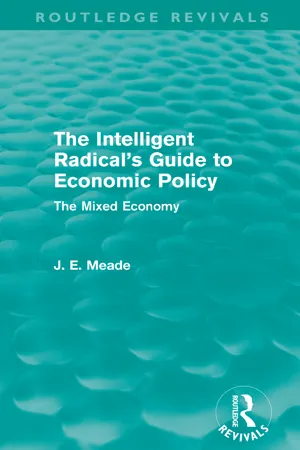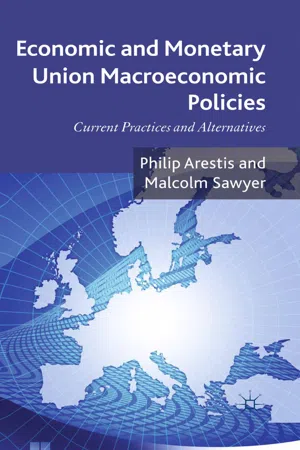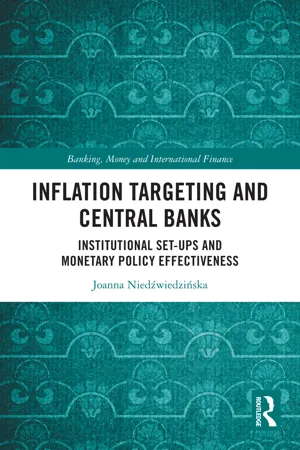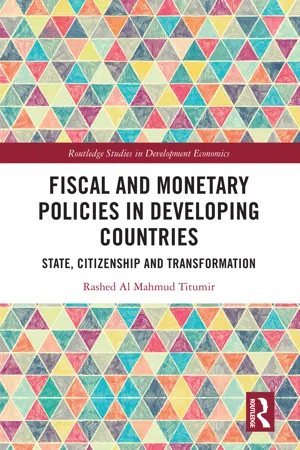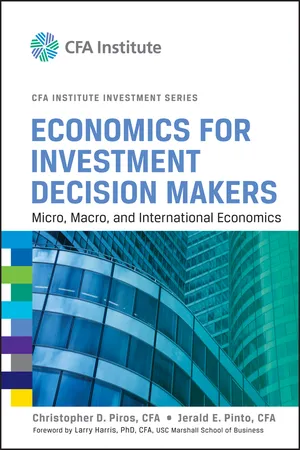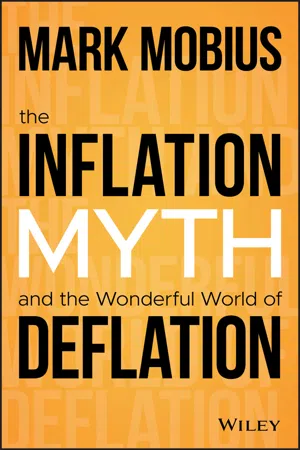Economics
Policies to Reduce Inflation
Policies to reduce inflation typically involve actions taken by central banks or governments to decrease the rate of inflation in an economy. These policies may include increasing interest rates, reducing government spending, or implementing tighter monetary policies. The goal is to stabilize prices and maintain a healthy level of inflation conducive to economic growth.
Written by Perlego with AI-assistance
Related key terms
Related key terms
1 of 4
Related key terms
1 of 3
8 Key excerpts on "Policies to Reduce Inflation"
- eBook - ePub
- James E. Meade(Author)
- 2012(Publication Date)
- Routledge(Publisher)
II
The Control of Inflation
A necessary condition for the design of an effective set of radical economic policies and institutions is the existence of a monetary unit of account with a more or less dependable, stable, real purchasing power. Accordingly in this chapter we shall attempt to outline : first, the mechanisms of price inflation; second, the disadvantages, particularly for the radical’s set of policies, of price inflation; and, third, in the light of the mechanisms and disadvantages of inflation the design of policies for the control of inflation by means which will help rather than hinder the intelligent radical’s package of other economic policies.By inflation we mean simply a rise in the general level of money prices of goods and services. The causes of an inflationary situation are often divided into two groups, namely those which originate from a demand inflation and those which originate from a cost inflation. It is convenient to consider the phenomenon of price inflation under these two broad headings, though, as we shall see, the two types of inflation are in fact very closely interconnected.A demand inflation occurs when there is ‘too much money chasing too few goods’. The total demand for the goods and services produced in a country can be catalogued under the following four heads : (1) the expenditure by individual citizens for the purchase of domestically produced goods and services for individual consumption – food, clothing, heating, and other consumption goods; (2) the expenditure by business concerns on domestically produced buildings, machinery, plant, and other equipment in order to invest in additional productive capacity; (3) the purchase by the government and local authorities of domestically produced goods and services for public purposes; and (4) the purchase by foreigners of exports of the country’s domestically produced goods and services. - eBook - ePub
Economic and Monetary Union Macroeconomic Policies
Current Practices and Alternatives
- P. Arestis, Kenneth A. Loparo(Authors)
- 2013(Publication Date)
- Palgrave Macmillan(Publisher)
interest rate policy should be set so that the real rate of interest is as low as possible in line with the trend rate of growth. In this sense, a real rate of interest in line with the perceived trend rate of growth could be targeted so that the nominal rate is set by the central bank equal to the target rate plus the expected rate of inflation. Further, the operations of the central bank should ultimately be directed towards financial stability and this objective of financial stability should be placed as the most significant one for the central bank, requiring the development of alternative policy instruments alongside the downgrading of interest rate policy and of any notion of inflation targeting;(iii)exchange rate policy is also important. Changes in the exchange rate affect the domestic economy: primarily in terms of the level of demand and hence economic activity and, rather weakly, in terms of inflation. Intervention by the central bank in the foreign exchange market with the specific aim to stabilise the exchange rate may be important in this respect as argued below, where we suggest control and direct manipulation of the exchange rate by the central bank.We elaborate in what follows on these economic policies. The instruments of economic policy summarised above to achieve the objectives, also alluded to above, are discussed in what follows beginning with monetary policy.7.3 Monetary policy We examine two dimensions of monetary policy: Interest rate policy and financial stability. we begin, however, with some general observations before we return to the two dimensions. 7.3.1 General observationsThe EMU policy arrangements discussed earlier in this book suffer from a number of defects. First, if inflation is induced by a demand shock (if, for example, a higher level of demand pushes up inflation) then a policy to influence aggregate demand, and thereby, it is hoped, inflation may have some validity. But such a policy is powerless to deal with cost inflation or supply shock inflation. A supply shock would lower (raise) output whilst raising (lowering) inflation. The experience with inflation in years such as 2007/08 and 2011, when inflation increased in view of higher oil prices and imported raw materials is very telling. Central banks did not use the rate of interest to contain inflation for the very reason just alluded to, namely the supply shock type of inflation. - eBook - ePub
Judging Economic Policy
Selected Writings Of Gottfried Haberler
- Richard J Sweeney(Author)
- 2021(Publication Date)
- Routledge(Publisher)
3Domestic Macroeconomic PolicyDOI: 10.4324/9780429046858-3Inflation: Causes and CuresExplaining Stagflation1
Introduction. I take it for granted that inflation is a monetary phenomenon in the sense that there has never been a serous inflation without an increase in the quantity of money and that a serious inflation cannot be slowed or stopped without restrictions on monetary growth. Recognition of this fact does not, however, imply the assumption of a strict parallelism between changes in M and P, however these terms may be defined. Nor does it preclude going behind changes in M and analyzing the economic, social and political forces that shape the observed changes in M, in other words, identifying causes of inflation more remote than changes in M. Nor does it mean that anti-inflation policy must be confined to monetary policy, i.e. measures to restrict monetary growth. Changing or eliminating some of the factors which cause excessive monetary growth may be an indispensable ingredient, along with monetary restraint, of an economically effective and politically feasible anti-inflation policy.Monetarists are fully aware that the parallelism between Mand Pis not quite strict. There is in the short-run a sizable and variable lag between changes in M and P, and there are longer-run, structural changes in the correlation. In other words V, the velocity of circulation of money, although neither a volatile nor a plastic magnitude as Keynesians assume, is subject to change. It changes cyclically and it seems to have a secular downward trend; occasionally it displays longer swings. For example, during World War II, price control, rationing and a sharply reduced supply of durable goods induced a sharp increase in consumer savings; and a decrease in consumer credit depressed V to an abnormally low level. This was followed by a longish period of rising V after the war. Prolonged inflation naturally has the effect of speeding up velocity, as recent developments have again demonstrated. The rise in V in an inflation2 - eBook - ePub
Inflation Targeting and Central Banks
Institutional Set-ups and Monetary Policy Effectiveness
- Joanna Niedźwiedzińska(Author)
- 2021(Publication Date)
- Routledge(Publisher)
32Considering the above observations and the recent debates, nowadays the mainstream view seems to see room for using monetary policy to offset shocks hitting an economy, taking into account both their real and nominal effects, and associating significant cost to high and to excessively low inflation. In a more traditional approach, this would simply mean that monetary policy should focus on providing price stability, at best in such a way as to mitigate output fluctuations (Clarida et al., 1999). By doing this, it will add to the overall stability of the economy. Since maintaining price stability proved not to be a sufficient condition for safeguarding financial stability, in more current discussions, what has been argued is the need to broaden central banks’ mandates by including financial stability as another goal for monetary authorities. However, recognising the limitations of monetary policy, extending the mandates of central banks can be seen rather as assigning monetary authorities an additional task that requires a separate set of instruments (Taylor, 2011, pp. 136–138). Irrespective of the ongoing disputes, the most general point that should be uncontroversial for most economists is that monetary policy should serve as a stabilising tool—either in a narrower or a broader sense, depending on whether one also considers financial stability as a monetary policy goal.These conclusions have been reflected in the monetary policy strategies currently used by central banks. In particular, they have been incorporated into an inflation targeting framework.1.3 Defining the concept of a monetary policy strategy and its institutional set-ups
Regarding the definition of a monetary policy strategy, as with almost any concept developed within economics, various formulations are possible and no agreement on a specific definition has been reached. In general, a strategy should provide guidance to monetary authorities on how to use policy instruments in order to achieve the final goals (Duwendag et al., 1995, p. 282). In slightly more technical terms, it can also be described as a central bank’s reaction function and its communication with the public, together with transparency about the decision-making process (Houben, 2000, p. 2).33 Taking yet another angle (Borio, 2001, p. 2), a strategy can be seen as a set of central bank objectives (including the final goals, such as price stability or long-term growth) and intermediate targets (such as exchange rates, money, or asset prices). According to Grostal et al. (2016, pp. 12–13), it also includes operating targets (such as short-term money market rates) and monetary policy instruments (such as official interest rates or required reserves) used to reach the specified goals.34 - eBook - ePub
- Susan Howson(Author)
- 2013(Publication Date)
- Routledge(Publisher)
18The Control of InflationMeade returned to the problem of inflation in his inaugural lecture as Professor of Political Economy in the University of Cambridge, which he gave on 4 March 1958. He also submitted the published version (Cambridge: Cambridge University Press, 1958) as his written evidence to the Radcliffe Committee on the Working of the Monetary System.I
The purpose of this lecture is to consider how one can best put a stop to the inflation of prices. But before we try to find the answer it is useful to know whether this is an important question or not. For the extent to which we should be prepared to re-cast our present policies and institutions in order to avoid an inflation of prices will depend upon the importance which we attach to the objective of stable prices.If it were a question of stopping a serious price deflation, it would be a waste of time to ask whether the objective was an important one. Such a deflationary fall in selling prices, when money wage-rates cannot easily be lowered, will impede economic growth and raise unemployment. This has been a familiar and agreed theme among economists since the Great Depression of the 1930s. But during the last decade prices in this country have been rising by 4 or 5 per cent per annum, and it is worth pausing to ask whether we need to make any very great efforts to prevent a continuing inflation of money prices and costs of this kind. Might we not remain content with policies and institutions which were such as to avoid deflations, even if they resulted in some such degree of continuing price inflation?Indeed, a moderate and steady rate of price inflation may have some beneficial effects. It may relieve the community from the dead hand of debt. A large national debt, in my opinion, introduces more serious deadening disincentives into the economy than are generally realised. Between 1948 and 1957 the general level of prices rose by some 50 per cent, which is sufficient to reduce by one-third the real value of a given money debt. We did not remove our great war debt by a levy or repudiation; but its weight has been substantially reduced through inflation. - eBook - ePub
Fiscal and Monetary Policies in Developing Countries
State, Citizenship and Transformation
- Rashed Al Mahmud Titumir(Author)
- 2021(Publication Date)
- Routledge(Publisher)
7 Price, Inflation and Monetary Policy
DOI: 10.4324/9781003201847-7Introduction
The policy of central banks changed significantly from the late 1970s in favour of a policy that solely focused on price stability, in contrast to a previous policy perspective that kept an employment objective along with a price stability objective. This period marks the beginning of neoliberal ideas, of which an integral part was a shift in monetary policy stance on the global stage (Stanford, 2008). Despite putting a greater emphasis on inflation, however, many Western countries observed the persistence of high inflation starting from the mid-1960s. What made inflation in this period special compared to that in earlier periods was its continuous growth, persistence and self-sustaining impetus, which proved incurable by orthodox fiscal and monetary measures and later resulted in extensive and prolonged unemployment. It was also believed that if monetary and fiscal policies were used to curb inflation, the cost would be discouragingly high (Hall, 1982).The experiences of emerging and transitioning countries have not been the same regarding monetary policy though. Asian and Latin American countries faced monetary instability, high inflation and incessant capital flight. In this regard, emerging countries opted for exchange-rate regimes before they were hit with high inflation in the 1990s. Eventually, emerging countries scrapped pegged exchange rates for floating exchange rate regimes. Inflation-targeting approaches initiated by the countries brought the inflation rate down from 400 percent at the start of 1990s to below 10 percent in the space of 10 years (Mishkin & Savastano, 2002). Developing countries are faced with a lack of institutional capacity for monetary stability. Shifts from one monetary regime to another are thus problematic. The choice between inflation-targeting and growth-stimulating policies is a particularly difficult one. This chapter provides the theoretical foundation for different policy regimes. - eBook - ePub
Economics for Investment Decision Makers
Micro, Macro, and International Economics
- Christopher D. Piros, Jerald E. Pinto(Authors)
- 2013(Publication Date)
- Wiley(Publisher)
Over the past two to three decades the consensus among economists has been that unanticipated and high levels of inflation can have an impact on real things like employment, investment, and profits, and therefore that controlling inflation should be one of the main goals of macroeconomic policy. In summary:Expected inflation can give rise to:- Menu costs.
- Shoe leather costs.
- Lead to inequitable transfers of wealth between borrowers and lenders (including losses to savings).
- Give rise to risk premiums in borrowing rates and the prices of other assets.
- Reduce the information content of market prices.
2.3.2 Monetary Policy Tools5
Central banks have three primary tools available to them: open market operations, the refinancing rate, and reserve requirements.2.3.2.1. Open Market Operations
One of the most direct ways for a central bank to increase or reduce the amount of money in circulation is via open market operations . Open market operations involve the purchase and sale of government bonds from and to commercial banks and designated market makers. For example, when the central bank buys government bonds from commercial banks, this increases the reserves of private-sector banks on the asset side of their balance sheets. If banks then use these surplus reserves by increasing lending to corporations and households, then via the money multiplier process explained in Section 2.1.2, broad money growth expands. Similarly, the central bank can sell government bonds to commercial banks. By doing this, the central bank causes the reserves of commercial banks to decline, reducing their capacity to make loans (i.e., create credit) to households and corporations and thus causing broad money growth to decline through the money multiplier mechanism. In using open market operations, the central bank may target a desired level of commercial bank reserves or a desired interest rate for these reserves.2.3.2.2. The Central Bank’s Policy Rate
The most obvious expression of a central bank’s intentions and views comes via the interest rate it sets. The name of the official interest rate (or official policy rate or just policy rate - Mark Mobius(Author)
- 2020(Publication Date)
- Wiley(Publisher)
Central banks have been criticized for tightening money supply even when borrowing rates are very low, but then adopting an inflationary fiscal policy when inflation is rising. There is a continuous battle between economists and policymakers regarding the right interpretation of the data and what actions should be taken. There are the liberals who argue that by relaxing fiscal policy, i.e. increase government spending, the economy will grow and debts will be easier to pay. Also, by lowering interest rates, government debt will be easier to pay. The conservatives reject the idea of government borrowing and say there should not be government deficits. In recent years, the liberal philosophy has held sway even among so‐called conservatives. People with debts need inflation so their debts can be paid in inflated currency. A number of economic theories have been promulgated and adopted by governments and central banks around the world. This has resulted in sustained efforts to manipulate and control inflation. The Phillips Curve, Taylor Rule, Fisher Effect, and other economic theories continue to have a big impact on government actions.The Phillips Curve
The Phillips Curve is an economic theory developed by A. W. Phillips, a New Zealander who was a professor of economics at the London School of Economics. In 1958, he came up with the idea that inflation and unemployment have a stable and inverse relationship so that when inflation goes up, unemployment declines, and vice versa. Therefore, the idea was that economic growth was accompanied by inflation and this led to more jobs and less unemployment. It was a theory that was attractive to many governments, which led them to implement a target inflation rate when economies experienced stagnant economic growth and high unemployment. The theory did not hold up in the mid‐1970s when between 1973 and 1975, the US economy had six consecutive quarters of declining GDP while, at the same time, inflation numbers tripled. That was called “stagflation” and directly contradicted the Phillips Curve theory.
Index pages curate the most relevant extracts from our library of academic textbooks. They’ve been created using an in-house natural language model (NLM), each adding context and meaning to key research topics.
Explore more topic indexes
Explore more topic indexes
1 of 6
Explore more topic indexes
1 of 4
